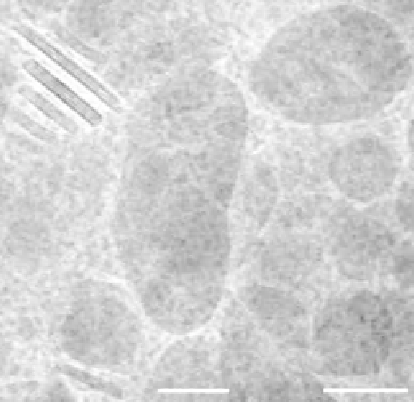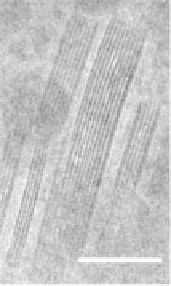Biomedical Engineering Reference
In-Depth Information
Figure 6.5
Cryo-TEM micrograph of tristearin nanoparticles (scale bar
=
100 nm) showing a
characteristic plate-like morphology in the
polymorphic form. (Reproduced with permission from
Langmuir, Bunjes
et al
., 2007, copyright 2007, the American Chemical Society.)
β
like (Bunjes
et al
., 2007) (Figure 6.4), and subsequent gelation of the dispersion. For
example, tristearin droplets with particle sizes around 100-200 nm crystallized in the
form
were spheriodal in shape with some possible elongation and also with concentric layers of
TAG molecules. When these droplets converted to the
α
modification they were plate-like
nanocrystals with a planar layered internal structure (Figure 6.5). One reason for this change
in shape is that
β
-nucleation occurs quickly at multiple locations throughout the droplet to
form a polycrystalline particle. The
α
α
to
β
transition is slower and perhaps one
β
crystal
forms initially, which grows at the expense of existing
crystals within the droplet yielding
a single monocrystalline particle. For the larger droplet sizes (i.e., >1 μm) shape change and
stack formation were not observed on crystallization (Bunjes
et al
., 2003 ). This may be
because there are a greater number of
α
-nucleation events within the larger droplets yielding
a grained structure, with approximately the same shape as the starting droplet.
The
β
-form plates can pack together in stacks. The interpolate distance has been measured
by small angle X-ray scattering (SAXS) and transmission electron microscopy (TEM) to be in
the order of 20 nm (Illing
et al
., 2004 ; Unruh
et al
., 2002). It may be possible in some cases to
reduce the tendency of plate-like particles to associate by adding more surfactant to cover the
increased interfacial area (Westesen and Siekmann, 1997; Helgason
et al
., 2008 ). Presumably,
there is an attractive force between fat crystals suspended in water but the effective magnitude
of the force is greater between flat plates than between spheres as it acts over a larger area.
β
6.6 LOCALIZATION OF BLI IN SOLID LIPID
NANOPARTICLES
BLI dissolved in liquid oil nanoemulsions will redistribute on crystallization of the fat
(Figure 6.6). Even if the BLI is soluble in the liquid oil (i.e., forms a one-phase solution),
crystallization of the carrier lipid will likely cause a phase separation. Figure 6.6a shows the







Search WWH ::

Custom Search